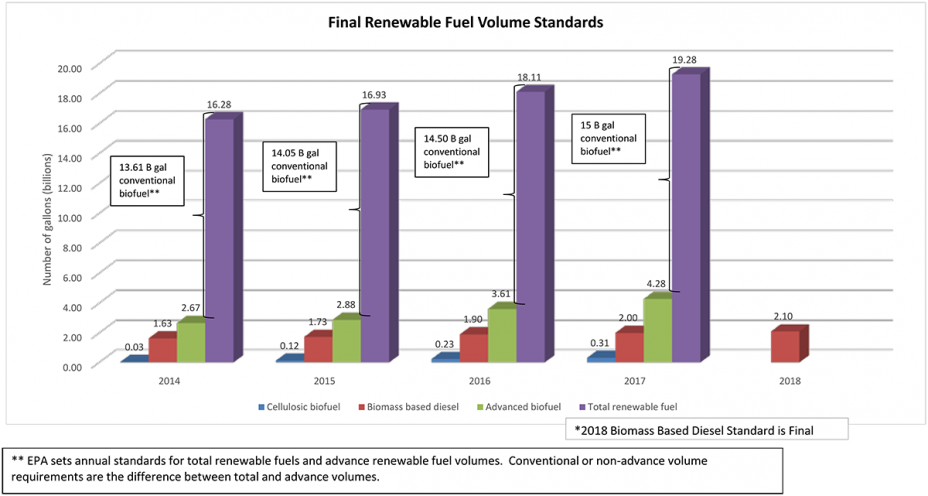Final Renewable Fuel Standards for 2017, and the Biomass-Based Diesel Volume for 2018
On this page:
Rule Summary
EPA finalized the volume requirements and associated percentage standards that apply under the RFS program in calendar year 2017 for cellulosic biofuel, biomass-based diesel, advanced biofuel, and total renewable fuel. EPA also finalized the volume requirement for biomass-based diesel for 2018.
The final volumes represent continued growth over historic levels. The final standards meet or exceed the volume targets specified by Congress for total renewable fuel, biomass-based diesel, and advanced biofuel.
| 2014 | 2015 | 2016 | 2017 | 2018 | |
|---|---|---|---|---|---|
| Cellulosic biofuel (million gallons) | 33 | 123 | 230 | 311 | n/a |
| Biomass-based diesel (billion gallons) | 1.63 | 1.73 | 1.9 | 2.0 | 2.1 |
| Advanced biofuel (billion gallons) | 2.67 | 2.88 | 3.61 | 4.28 | n/a |
| Renewable fuel (billion gallons) | 16.28 | 16.93 | 18.11 | 19.28 | n/a |
Total renewable fuel volumes grow by 1.2 billion gallons from 2016 to 2017, a 6 percent increase.
Advanced renewable fuel – which requires 50 percent lifecycle carbon emissions reductions – grow by roughly 700 million gallons between 2016 and 2017.
Non-advanced or “conventional” renewable fuel increases in 2017 meet the 15 billion gallon congressional target for conventional fuels.
The standard for biomass-based biodiesel – which must achieve at least 50 percent lifecycle greenhouse gas emission reductions compared to petroleum-based diesel – grows by 100 million gallons. The required volume of biomass-based diesel for 2017 is twice as high as the minimum congressional target.
Cellulosic biofuel – which must achieve at least 60 percent lifecycle greenhouse gas emissions reductions – grows by 35 percent over the 2016 standard.
The advanced biofuel standard – which is comprised of biomass-based diesel, cellulosic biofuel, and other biofuel that achieves at least 50 percent lifecycle greenhouse gas emissions reductions – increases by 19 percent over the 2016 standard.

Rule History
On May 18, 2016, EPA proposed the volume requirements and associated percentage standards that would apply under the RFS program in 2017 for cellulosic biofuel, advanced biofuel, and total renewable fuel. EPA also proposed the volume requirement for biomass-based diesel for 2018.
Additional Resources
- Final rule: Renewable Fuel Standard Program: Standards for 2017 and Biomass-Based Diesel Volume for 2018 (PDF)(59 pp, 1.66 MB, published December 12, 2016, About PDF)
- Response to Comments (PDF)(584 pp, 4 MB, EPA-420-R-16-019, November 2016, About PDF)
